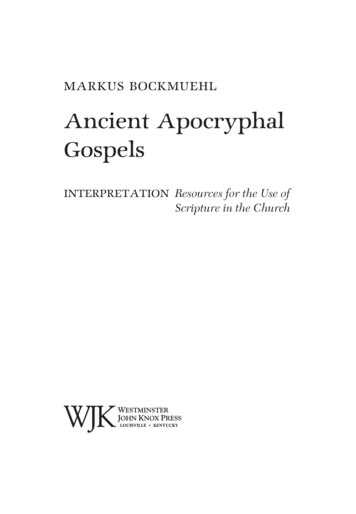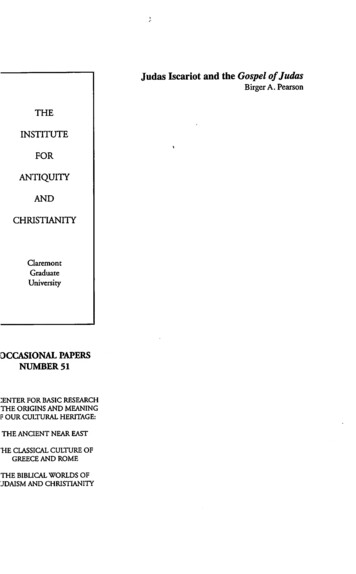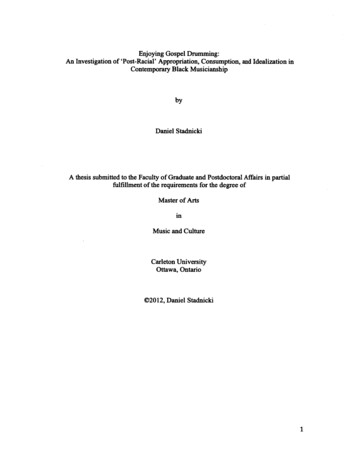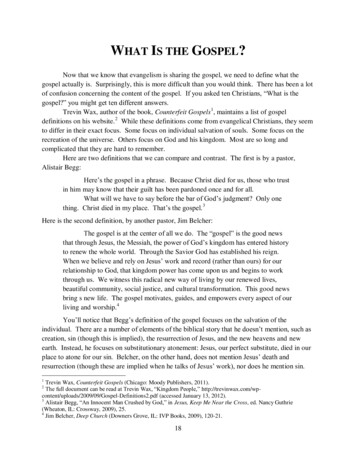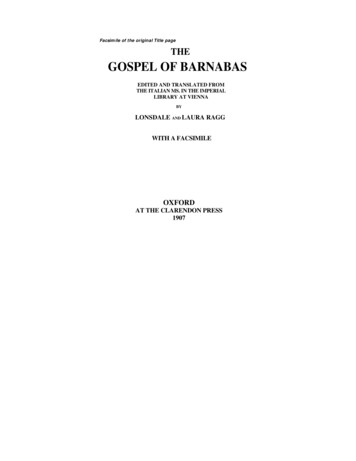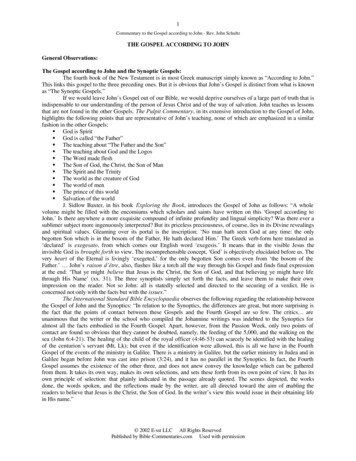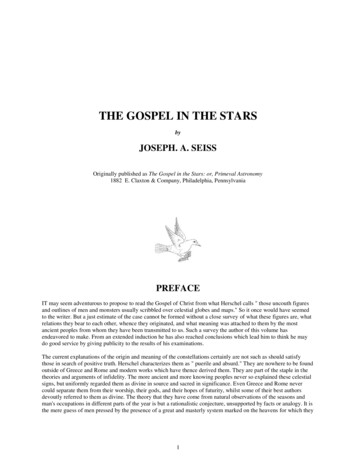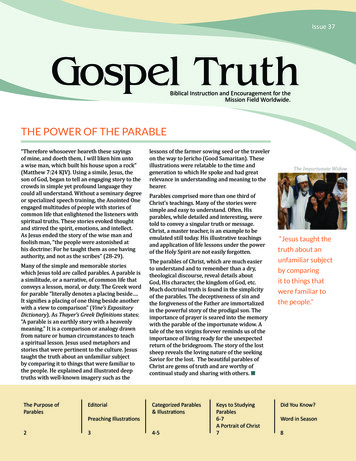
Transcription
Issue 37Gospel TruthBiblical Instruction and Encouragement for theMission Field Worldwide.THE POWER OF THE PARABLE“Therefore whosoever heareth these sayingsof mine, and doeth them, I will liken him untoa wise man, which built his house upon a rock”(Matthew 7:24 KJV). Using a simile, Jesus, theson of God, began to tell an engaging story to thecrowds in simple yet profound language theycould all understand. Without a seminary degreeor specialized speech training, the Anointed Oneengaged multitudes of people with stories ofcommon life that enlightened the listeners withspiritual truths. These stories evoked thoughtand stirred the spirit, emotions, and intellect.As Jesus ended the story of the wise man andfoolish man, “the people were astonished athis doctrine: For he taught them as one havingauthority, and not as the scribes” (28-29).Many of the simple and memorable storieswhich Jesus told are called parables. A parable isa similitude, or a narrative, of common life thatconveys a lesson, moral, or duty. The Greek wordfor parable “literally denotes a placing beside .It signifies a placing of one thing beside anotherwith a view to comparison” (Vine’s ExpositoryDictionary). As Thayer’s Greek Definitions states:“A parable is an earthly story with a heavenlymeaning.” It is a comparison or analogy drawnfrom nature or human circumstances to teacha spiritual lesson. Jesus used metaphors andstories that were pertinent to the culture. Jesustaught the truth about an unfamiliar subjectby comparing it to things that were familiar tothe people. He explained and illustrated deeptruths with well-known imagery such as theThe Purpose ofParablesEditorial23Preaching Illustrationslessons of the farmer sowing seed or the traveleron the way to Jericho (Good Samaritan). Theseillustrations were relatable to the time andgeneration to which He spoke and had greatrelevance in understanding and meaning to thehearer.Parables comprised more than one third ofChrist’s teachings. Many of the stories weresimple and easy to understand. Often, Hisparables, while detailed and interesting, weretold to convey a singular truth or message.Christ, a master teacher, is an example to beemulated still today. His illustrative teachingsand application of life lessons under the powerof the Holy Spirit are not easily forgotten.The parables of Christ, which are much easierto understand and to remember than a dry,theological discourse, reveal details aboutGod, His character, the kingdom of God, etc.Much doctrinal truth is found in the simplicityof the parables. The deceptiveness of sin andthe forgiveness of the Father are immortalizedin the powerful story of the prodigal son. Theimportance of prayer is seared into the memorywith the parable of the importunate widow. Atale of the ten virgins forever reminds us of theimportance of living ready for the unexpectedreturn of the bridegroom. The story of the lostsheep reveals the loving nature of the seekingSavior for the lost. The beautiful parables ofChrist are gems of truth and are worthy ofcontinual study and sharing with others. Categorized Parables& Illustrations4-5Keys to StudyingParables6-7A Portrait of Christ7The Importunate Widow“Jesus taught thetruth about anunfamiliar subjectby comparingit to things thatwere familiar tothe people.”Did You Know?Word in Season8
What the BibleTeaches about.Word of God2 Tim. 3:16-17; 2 Peter 1:20-21; Matt. 24:35Relationship of LoveMatt. 22:37-40; John 14:21-23; 1 John 4:7-11RepentanceActs 3:19; Acts 17:30; 2 Cor. 7:10New BirthJohn 3:3-7; 2 Cor. 5:17; Rom. 6:1-4;Eph. 2:1, 5-6Freedom From Sin1 John 5:18; Matt. 1:21; John 8:11Infilling of the Holy SpiritActs 19:2; Acts 15:8-9; Acts 1:8HolinessLuke 1:73-75; Heb. 12:14; 1 Peter 1:15-16;Titus 2:11-12; Rom. 6:22Kingdom of GodLuke 17:20-21; Romans 14:17; John 18:36The ChurchActs 2:47; Eph. 4:4-6; 1 Cor. 12:12-13; Col 1:18UnityJohn 17:20-23; Gal 3:28; Rev. 18:2-4OrdinancesMatt. 28:19-20; Matt. 26:26-30;1 Cor. 11:23-27; John 13:14-17Divine HealingLuke 4:18; Isaiah 53:4-5; James 5:13-16Sanctity of MarriageMatt. 19:5-6; Luke 16:18; Rom. 7:2-3;1 Cor. 7:10-11Outward Appearance1 Tim. 2:9-10; 1 Cor. 11:14-15; Deut. 22:5sThe Purpose ofparablesJesus used parables to teach a truth or to answer a question. He usedreal-life situations in His stories to connect with His audience. A lawyeronce stood tempting Jesus and asked Him: “Who is my neighbour?” (Luke10:29). Jesus proceeded to tell the story of the good Samaritan. Jesus thenasked: “Which now of these three, thinkest thou, was neighbour unto himthat fell among the thieves?” (v. 36). The answer was evident in the relatedstory, but it caused the listeners to consider and think for themselves. Itelicited truth from those who otherwise might have rejected a declarativestatement.ElicitR evealConcealThe parables of Christ often reveal the truthin a way that a simple declaration wouldnot. Those who have honest, seeking heartswill hear and understand. The telling ofparables is a way to convey and reveal truthin ways easy to be understood as in theabove illustration.Other parables that Jesus told werepresented in such a way as to conceal truthfrom those who were choosing to walk indarkness. “And the disciples came, and saidunto him, Why speakest thou unto them in parables? He answered andsaid unto them, Because it is given unto you to know the mysteries of thekingdom of heaven, but to them it is not given. For whosoever hath, to himshall be given, and he shall have more abundance: but whosoever hathnot, from him shall be taken away even that he hath. Therefore speak I tothem in parables: because they seeing see not; and hearing they hear not,neither do they understand.” (Matthew 13:10-13). The unbeliever mayincorrectly understand the primary point of a parable, as it is hidden tothose who “hear not.” It was not uncommon for the disciples to return toChrist and ask for a more in-depth explanation of a parable.Pr eserveParables are easy to recall for their detailed imagery and hence areuseful to remember spiritual truths. They were and remain vital to thepreservation of truth for people of all cultures and backgrounds. End of Time2 Peter 3:7-12; John 5:28-29; 2 Cor. 5:10;Matt 25:31-46PacifismLuke 6:27-29; Luke 18:20WorshipJohn 4:23-24; Eph. 5:19; 2 Cor. 3:17Great CommissionMark 16:152Gospel Truth Issue 37The Gospel Truth is a quarterly periodical published in the interest of the Church ofGod for instruction and encouragement in the truths of the Bible. Visit us online atwww.thegospeltruth.org and subscribe to the email notification list to receive currentpublications. The Gospel Truth is printed in many countries for local distribution and issupported by freewill offerings. A tax receipt will be sent upon request.—Editor, Michael SmithGospel Truth, P.O. Box 2042, Nixa, MO 65714 USAeditor@thegospeltruth.org
EditorialAnd with many such parables spake he the word unto them, as they were able tohear it. But without a parable spake he not unto them: and when they were alone,he expounded all things to his disciples. —Mark 4:33-34The Gospel Truth this quarter highlights the parables of Jesus. Parables were animportant part of the teachings of Christ, and they should be a valuable resourcefor teaching today. Parables illustrate truth in ways that a list of facts can neverdo. While Christ’s teachings were not pretentious, He spoke to the heart of issues in relativesimplicity. Bible scholars and theologians quibble at times over the definition of a parable andwhat makes something a parable versus an illustrative story. A true parable is a story with ahidden truth containing a comparison of a natural occurrence with a spiritual lesson.My burden is to encourage people to study the parables and to immerse themselves in thewonderful teaching illustrations of Christ. Everyone learns differently, and Christ obviouslythought it important enough to reach people with stories and examples that the truth might beunderstood.A few years ago, I had the privilege of conducting a ministers’ meeting over a number of dayswith a group in Africa. On many past occasions we had teaching sessions and doctrinal studiestogether. I felt the need for something different. God inspired me with the power of the parables.My eyes were opened to the wonderful truths that are contained in the parables of Christ.For days, the ministers studied the parables and shared the lessons together. I was so blessedto be able to give pertinent lessons after each presentation that dealt with a wide array ofsubjects: prayer, forgiveness, salvation, the love of God, the judgment, sin, the Kingdom of God,mercy, eternity, heaven, hell, evangelism, and the list goes on. There is much doctrine and truthcontained in these stories, and they engage people in a way that lecture-style teaching cannot.Visit us atwww.thegospeltruth.orgto subscribe and accesspublication archives.I pray that God will inspire you to read the parables and discover the wealth and powercontained therein.Michael W. SmithJuly 2021Preaching IllustrationsModern illustrations and life stories arevaluable in relating truth to an audience.Illustrations can engage the people and maketruth relevant in the light of current situationsand culture. However, while sharing storiesto bring a point can be an important tool inthe arsenal of the preacher, the minister ofChrist must not become an entertainer or acomedian. Our job is to preach the Word ofGod. If a story helps, then use it, but do notlet the storytelling take precedence over thetruth itself.It is also important when sharing anillustration not to try to make something anissue of truth because it “fits” your example orstory. Many a preacher in using an illustrationhas erred in getting the role of truth andillustration reversed. Something is truthbecause of the Word of God, not because wetell an engaging story from which we create atruth. www.thegospeltruth.org3
Parables of Jesus“And He spake a parable unto them saying.”ParableMatthewMarkLukeKingdom of HeavenThe Sower13:3-8, 18-234:4-8, 14-218:5-8, 11-15The Mustard Seed13:31-324:30-3213:18-19The Leaven13:33The Hidden Treasure13:44The Pearl13:45-46The Growing Seed13:20-214:26-29Loss and RedemptionThe Lost Sheep18:10-1415:1-7The Lost Coin15:8-10The Prodigal Son15:11-32Obedience/DisobedienceThe House on the Rock7:24-27The Two Sons21:28-326:47-49The Unprofitable Servants17:7-10StewardshipThe Lost SheepThe Talents25:14-30The Shrewd Manager16:1-13The Pounds19:11-27ChristThe Wicked Husbandmen21:33-45The Sower & the Seed4Gospel Truth Issue 3712:1-1220:9-19
The Prodigal SonParableMatthewMarkLukePrayerThe Friend at Midnight11:5-13The Unjust Judge18:1-8The Pharisee & Publican18:9-14Love and ServiceThe Good Samaritan10:30-37ForgivenessThe Unmerciful Servant18:21-35The Two Debtors7:41-43Eschatology/PreparednessThe Tares13:24-30, 36-43The Net13:47-50The Laborers in the Vineyard20:1-16The Wedding Banquet22:1-14The Rich Fool12:16-21The Watchful Servants13:34-37The Wicked/Faithful Servant24:45-51The Ten Virgins25:1-1312:35-4012:42-48The Barren Fig Tree13:6-9The Great Supper14:15-24Selected Stories & IllustrationsStory/lllustrationThe Lost CoinMatthewMarkLukeSalt of the Earth5:139:5014:34-35The Candlestick5:14-164:21-228:16-18Offending Eye and Hand5:29-30; 18:8-99:43-47Laying up Treasure6:19-21Fowls and Lilies6:25-3412:22-32Mote and Beam7:1-56:41-42Strait Gate and Broad Way7:13-14Camel/Needle’s Eye19:23-24Cup and Platter23:25-26The Sheep and Goats25:31-4610:23-2518:24-2511:37-39The Lowest Seat14:7-14Building a Tower/Going to War14:25-33The Rich Man and Lazarus16:19-31The Good ShepherdJohn 10:1-16www.thegospeltruth.org5
Keys to StudyingParablesThe study of parables is an interesting and profound way to learn many of thedoctrines and teachings of Christ. They are more than stories; they are practicaltools to reveal deep doctrinal truths. The primary purpose of a truth conveyed in aparable will never contradict other doctrinal scriptures; rather, other scriptures andprophecies more difficult to understand should always be interpreted to agree withthe simplicity of the teachings of Christ. It is vital to examine parables with honestyand openness to more fully grasp their true significance. The tips below can helpfacilitate a sound approach to understanding the wonderful parables of Jesus Christ.Consider the Literary ContextThe Talents“The interpretationof a parable shouldbe in harmonywith the rest of thescripture and theteachings of Christand the apostles.”Study the context of the parable. Examine whatis said in the text before and after the parable.Often, Jesus explicitly states the purpose ormeaning of the parable told. The parable of thepersistent widow and the judge inLuke 18:2-6 could be badly misinterpretedwithout considering the context. One mightinfer by the story itself that God is unjust anduncaring. That is not the point of the parable;rather, Jesus stated the purpose in verse one:“And he spake a parable unto them to this end,that men ought always to pray, and not to faint.”Examine Details CorrectlySome parables have details that do not havegreat spiritual significance. They are givento enhance the story and to paint a pictureillustrating an overriding spiritual truth. Theparable of the unjust judge does not illustrateGod but rather the details were used todemonstrate the importunity and tenacity ofthe widow. Be careful about attaching spiritualsignificance to every detail of a parable.It is said that “a parable is not designed to walkon all fours.” Every detail is not a unique lessonor analogy. For this reason, parables are notalways true allegories, as every detail does nothave spiritual meaning. Assigning a meaningto every detail can derail the true meaning of aparable.6Gospel Truth Issue 37Observe Repeated ImageryMany times images Jesus used are repeated inthe Scripture and have similar meaning fromparable to parable. Often, a master, judge, or kingrepresents God. Workers and servants illustratefollowers of God. Sheep represent children ofGod, and goats represent the unredeemed. Ashepherd, keeper of the vineyard, or the son of aking often represents Christ.What Prompted the Parable?When Jesus told parables, He was sometimesanswering a question or addressing an attitudeof people present. In Luke 15, Jesus told parablesof the lost sheep, the lost coin, and the prodigalson. Jesus told these parables in response to thePharisees and scribes murmuring and saying,“This man receiveth sinners, and eateth withthem (v. 2).” Understanding what instigatedthese parables helps one understand the point ofthe parables. In this case it was to demonstrateGod’s attitude toward sinners.Look for the One Main PointParables are told to make a point. As you read,carefully examine the central truth that Jesus isWorkers in the Vineyard
communicating and do not forget the context or thereason Jesus told the story to begin with. To help keepfocused on the point, consider the answers to thesequestions:1. What is the main contrast found in the parable?2. Who are the main characters?3. Who or what is the primary focus in the parable?4. What happens in the conclusion of the parable?Study the Cultural & Historical SettingGreater understanding of a parable can be derivedwhen one has a greater understanding of thehistorical and cultural setting. Some parables alludeto an event or practice that the Jews of the timeunderstood. This is exemplified with the parableof the wedding feast in Matthew 22:1-14. The manwithout a wedding garment was cast into outerdarkness. One might feel badly for this poor manwho did not have access to proper clothing until onelearns that at the time Jesus told this story, it wasthe practice of the host to provide a proper garmentfor his guests. In reality, the man had chosen not towear what was provided. This gives much greaterunderstanding to the doctrinal truth of hell andpunishment in this parable.InterpretationThe interpretation of a parable should be in harmonywith the rest of the scripture and the teachings ofChrist and the apostles. While truths can be derivedfrom a story, the reader must be careful aboutbuilding a doctrine from what could be an improperinterpretation of a parable. A parable is by definitiona contrast between two things. If the parable is aboutthe kingdom of God, the interpretation should beabout the kingdom of God, not how the story appliesto family, political events, etc. Remember, mostparables have a singular meaning.Throughouthistory peoplehave assignedfanciful, allegoricalmeanings to someparables. This oftencontradicts thestated or impliedpurpose of theparable. MartinLuther calledsome allegoricalinterpretations of the parables “amazing twaddle”and “altogether useless.”The Ten VirginsAnalyze and ApplyAfter a parable has been read and analyzed for properinterpretation, it is important to apply the doctrine tooneself. What does this teach me about the kingdomof God and of things to come? How does this truthapply in my life? What would God have me to do?The study of the parables will bring great blessings,challenges, and encouragement to the reader. Let usseek to know, study to understand, and pursue theknowledge of God that we may be found faithful at thecoming of our Lord. A Portrait of ChristThe Gospel of John is focused on giving a clear image of Jesus, His character and His nature. Thereare nine metaphors (figures of speech or illustrations) in John used to describe Jesus.1. I AM the Bread of Life/Living Bread—John 6:35, 48, 51.2. I AM the Light of the World—John 8:12; 9:5.3. Before Abraham was, I AM—John 8:58.4. I AM the Door—John 10:7, 9.5. I AM the Good Shepherd—John 10:11, 14.6. I AM the Resurrection and the Life—John 11:25.7. I AM the Way, the Truth, and the Life—John 14:6.8. I AM the True Vine—John 15:1, 5.9. I AM He—John 18:5-6.www.thegospeltruth.org7
Most of the parables of Christ are found in the synoptic gospels(Matthew, Mark, and Luke). While the Gospel of John contains a fewstories and illustrations, there are no true parables. John 10:6 KJVuses the word “parable”, but it is a different Greek word than otherparables and signifies an illustration or figure of speech.A Wordin SeasonContactThe Gospel TruthP. O. Box 2042Nixa, MO 65714USAEmail:editor@thegospeltruth.orgHoliness Unto the LordTHE PEARL OF GREAT PRICEAgain, the kingdom of heaven is like unto a merchant man, seeking goodly pearls: Who,when he had found one pearl of great price, went and sold all that he had, and bought it.—Matthew 13:45-46The goal of a merchant is to buy and sell merchandise inorder to attain the greatest profit. For centuries, at theexpense of their lives, people have sailed the vast oceansand explored new territories in pursuit of treasure andriches. The troubles and dangers encountered wereconsidered worth the risk when valued against thepotential gain of earthly possessions.Jesus spoke this parable illustrating salvation from sin andthe eternal reward as a pearl of great price. A merchant,when he has found such a great pearl, sells all his possessions in order to buy somethingof far greater value. Salvation is of more worth than any literal pearl. The seeker ofsalvation should with joy and gladness forsake all the things of this world in pursuit ofChrist and deliverance of sin. This wonderful pearl can and will only be attained by thosewho seek after it with all their hearts.Christians who are lazy and haphazard in their experience with God have either not trulyfound real salvation or they are in danger of losing that which they possess. To followJesus, we must forsake all to attain the power and joy of true salvation. We must seekafter that pearl of great price with our whole hearts, holding nothing back.When we find that pearl of great price, salvation from sin and hope of eternal life, it isaccompanied by an inward peace and joy that the world cannot give. As servants of theLord, may we convey the true worth and value of salvation. May our lives exemplify theriches and joy of full salvation. The enemy would like to cause us to paint a dire pictureof the necessity of selling all other possessions rather than focusing on the wonderfultreasure found in Jesus Christ.If you are saved and know Jesus Christ, you have a rare pearl of great price. Go tellsomeone else about this great salvation that they also may have eternal life. 8Gospel Truth Issue 37
Parables 2 Issue 37 Did You Know? Word in Season 8 Keys to Studying Parables 6-7 A Portrait of Christ 7 Categorized Parables & Illustrations 4-5 Editorial Preaching Illustrations 3 “Therefore whosoever heareth these sayings of mine, and doeth them, I will liken him unto a wise ma
